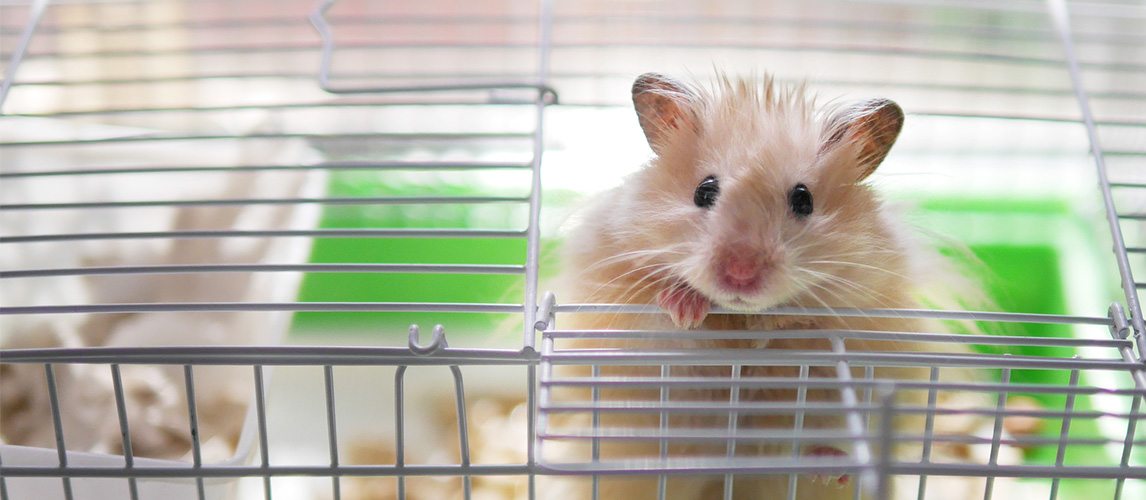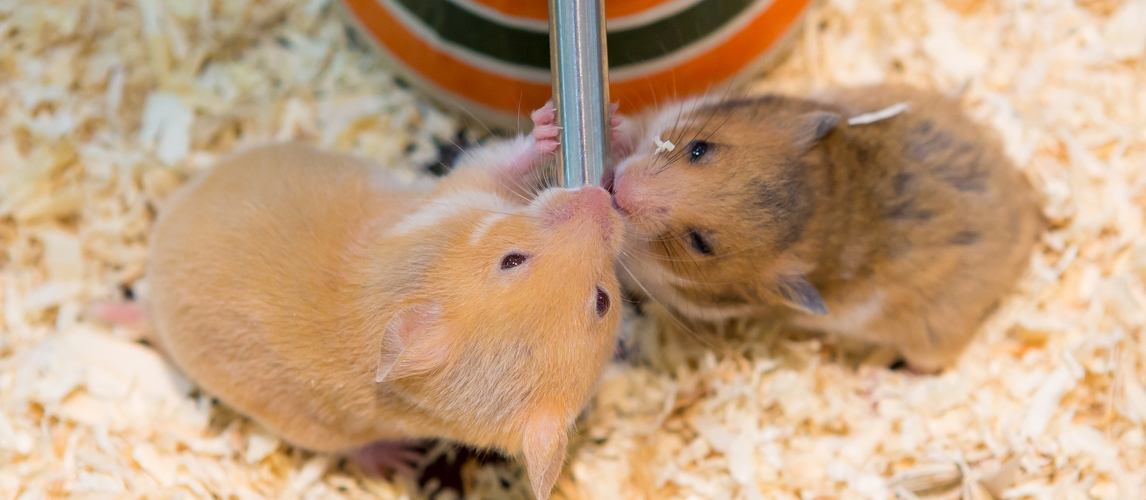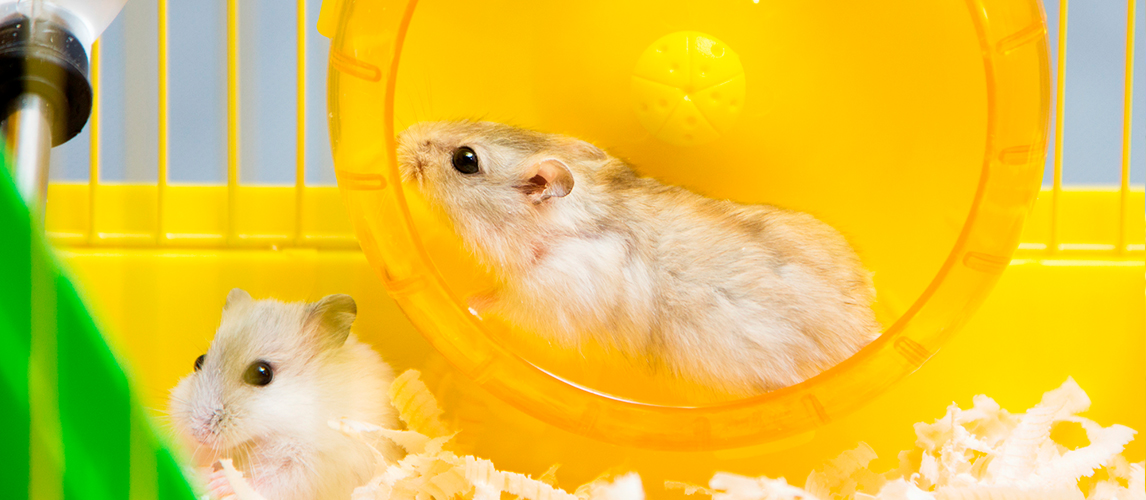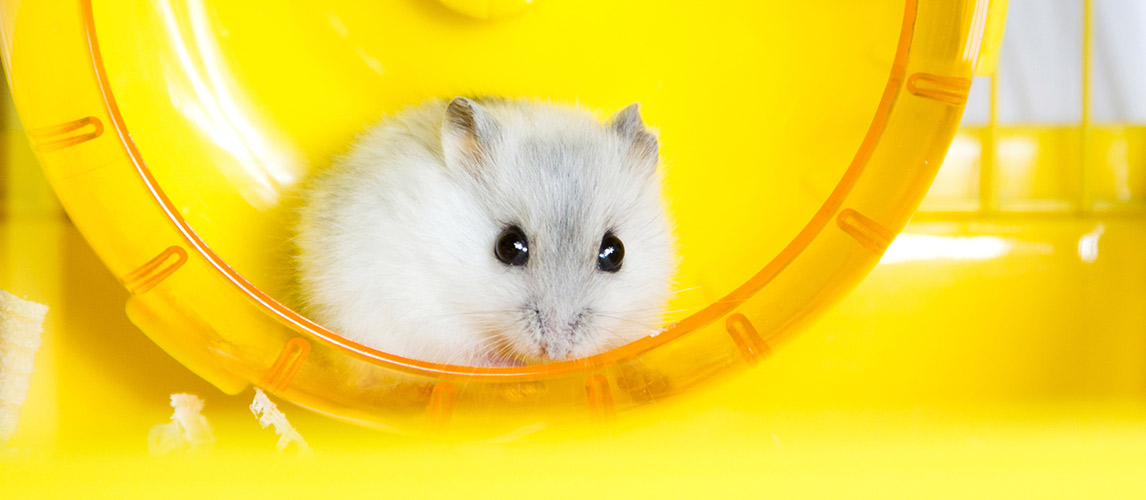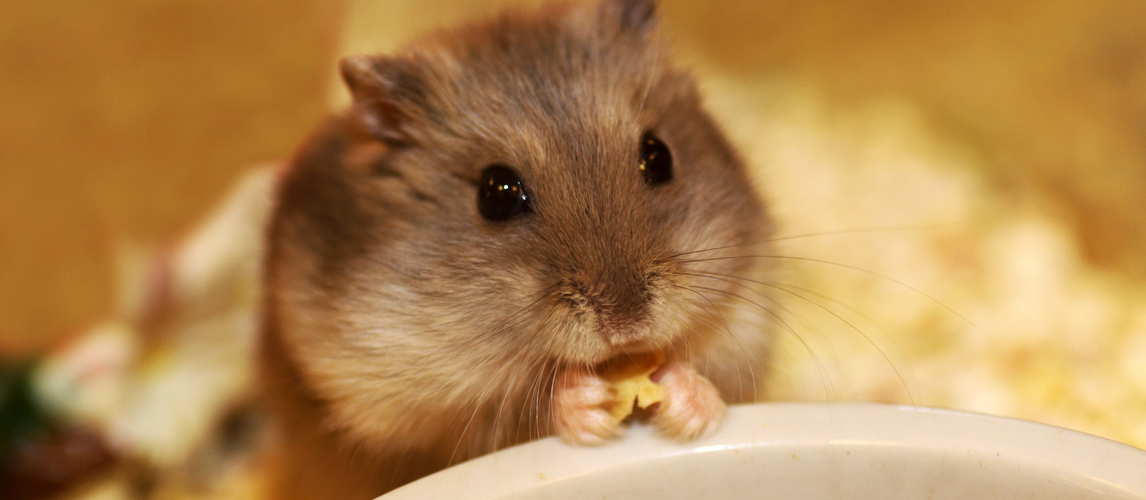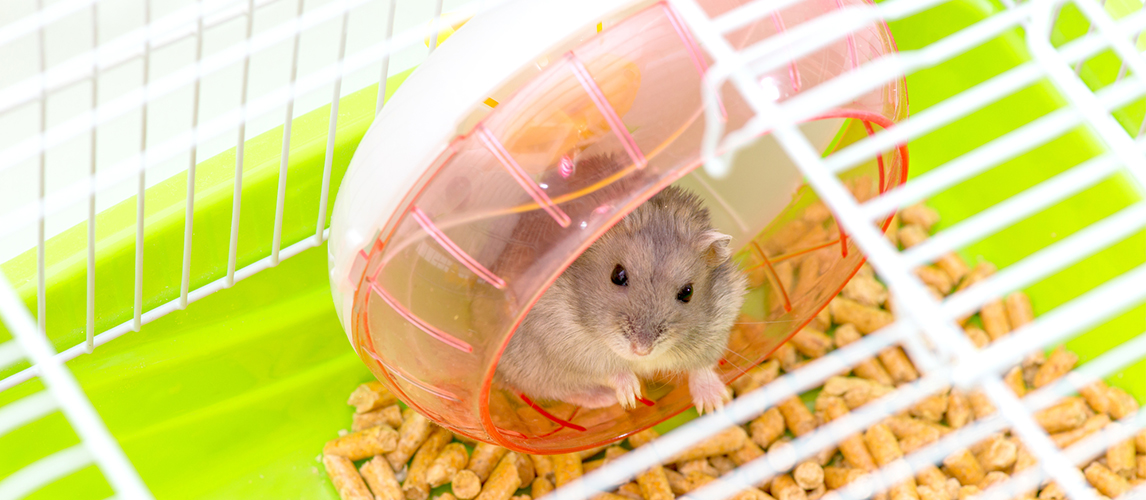Hamsters are amongst the most popular pets worldwide, and as cute as they are, these furry little creatures can escape instantly when not kept in a secure environment. A cage is, therefore, necessary, as it serves as their little habitat. However, not just any cage would do; rather than some groggy prison-like setup, a homey setting that makes it even easier to take care of a furry little companion should be the endgame. The cozier and healthier the cage is, the more comfortable and balanced your pet will be. Based on that, here are some of the best hamster cages on the market.
A Quick Glance at Our Favorites
| Product Name | Dimensions | Price | Rating |
|---|---|---|---|
| Prevue Pet Products Universal Small Animal Home | 32.5 x 19 x 17.5 inches | Buy on Amazon | 4.8 |
| Kaytee My First Home Multi-Level Habitat | 30.5 x 8.5 x 18.5 inches | Buy on Amazon | 4.3 |
| Ferplast Favola Hamster Cage | 23.62 x 14.37 x 11.81 inches | Buy on Amazon | 3.9 |
| Prevue Hendryx Deluxe Hamster and Gerbil Cage | 22. 5 x 12 x 12.5 inches | Buy on Amazon | 3.2 |
| MidWest Arcade Hamster Cage | 21.26 x 18.11 x 11.61 inches | Buy on Amazon | 4.2 |
| Midwest Deluxe Critter Nation Small Animal Cage | 36 x 24 x 39 inches | Buy on Amazon | 4.7 |
| Savic Hamster Heaven Metro Cage | 80 x 50 x 50 inches | Buy on Amazon | 4.3 |
The 7 Best Cages for Hamsters
1 Prevue Pet Products Universal Small Animal Home
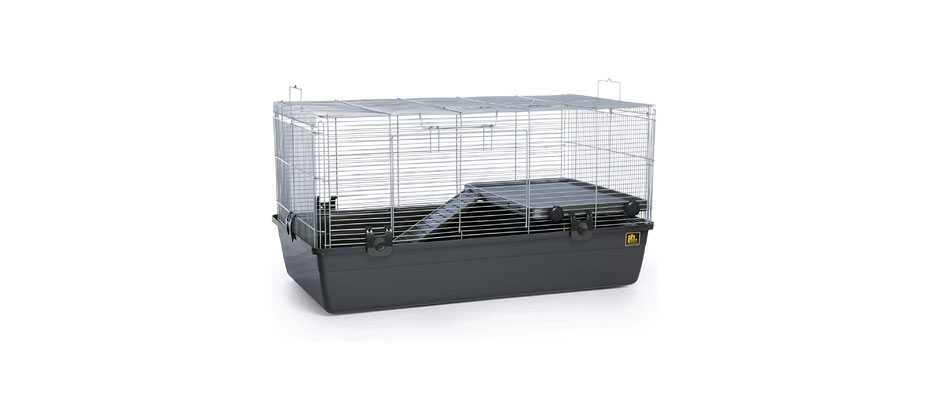
- Can be used by a number of small animals
- Fitted with two large entry doors
- It is roomy
- Fitted with a large tubby base
This Prevue Pet Products 528 Universal Small Animal Home offers a large tubby base that allows enough room for diverse movement and extra space to stock up on fun accessories. Thanks to the accompanying platform, the whole setup appears a lot neater and gives enough room for food and snacks of all sorts to be eaten without causing a mess in the rest of the cage. To crown it all up, this hamster cage offers a lightweight design that makes for all-around easy handling despite its size.
- It is easy to assemble
- Stellar bar spacing
- Provides an ample amount of space for your pet
- It is altogether not sturdy
- It is hard to clean
2 Kaytee My First Home Multi-Level Small Animal Habitat
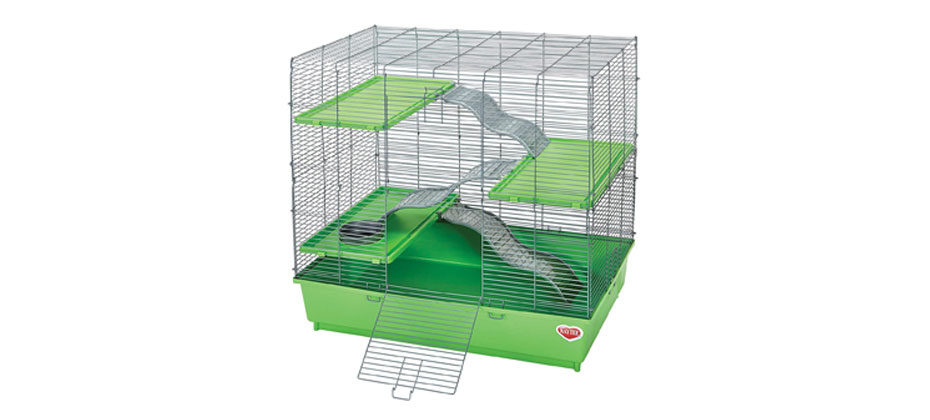
- It has multiple levels
- Fitted with a deep base
- It has chew-proof locks and wires
- It is easy to assemble
This next cage will practically serve as a mansion for your pet, with its deep base and multiple levels. So not only is the Kaytee My First Home Multi-Level Habitat convenient for furry little companions, but it is also perfect for their owners alike.
The base itself is as massive, so your pet has the option of running around there or simply climbing the steps to another level to see what it has to offer. Of course, with all the room available, your pet would hardly consider the thought of escaping. But if they do, the chew-proof latches are available to secure them.
Cleaning pet cages can be a huge hassle, but it needs to be done. To make the whole process easier, this cage is fitted with a deep base that stops litter and bedding from spilling. It’s a win-win for all parties involved.
- It is incredibly easy to clean
- It has an ample amount of space
- The different levels are great for exercise
- The bars are not immune to animals that chew away
- The flimsiness of the plastic stairs
- Not suitable for tiny critters
3 Ferplast Favola Hamster Cage
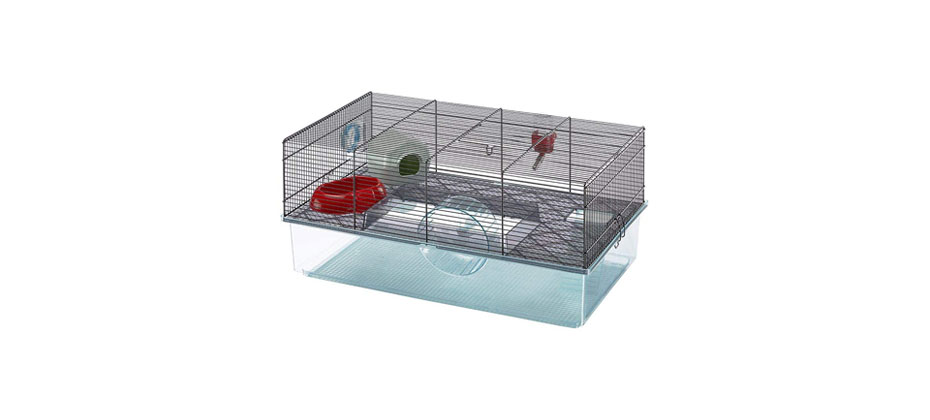
- Double floor living space design
- Combination of sturdy and pet-safe wire mesh and durable clear plastic
- Full accessories included such as water bottle, feeding dish, exercise wheel, hideaway, and ramp
- Built-in connection cap for expansion purposes
Looking at the Ferplast Black Hamster Cage, you’d be perplexed about what type of hamster house it is. It does resemble a wire cage because of its wire net upper floor, although its deep transparent bottom tray makes it a glass tank, too. Furthermore, the Ferplast is a two-level system that effectively separates the play and feeding quarters from the burrowing and eliminating sections. Nevertheless, the system already comes with an exercise wheel, feeding and drinking stations, and a hideout for your pet.
- Comes complete with all the basic things that small pets need
- Deep transparent bottom tray for unrestricted visualization
- Great expansion capabilities with other hamster habitat systems
- Ease to clean and maintain
- Some instances of flimsy construction of the cage
- May only use the accompanying water bottle as the height of the wire cage roofing may not allow for any other bottle
- Only one opening is located at the top of the cage; quite small, too
4 Prevue Hendryx Deluxe Hamster And Gerbil Cage
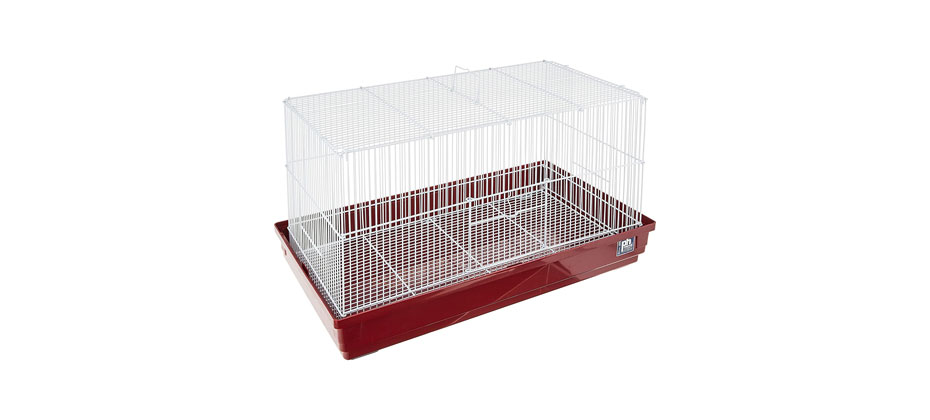
- Simple, clean, human habitat-inspired design theme
- Two house-styled hideouts on separate top shelves with ladder access
- Comes with paddle wheel type exercise wheel
- Easy-snap, deep, plastic bottom tray
- 5/16-inch vertical wire spacing
This hamster cage from Prevue Hendryx is amazingly beautiful and elegant as it features two home-inspired hideouts strategically placed on shelves accessed only by a ladder-like ramp. The wire frame construction is sturdy and durable while the bars are spaced safely to prevent hamsters from getting stuck in between. An exercise wheel already comes as standard
- Unique 2-house layout on elevated platforms
- Spacious 2-level living space
- Pet-safe access ramps
- Easily removable plastic bottom tray for ease of cleaning
- Wire cage can be easily cleaned
- Doesn’t come with other accessories like feeding and drinking accessories
- May have issues with structural soundness of the cage bars
5 MidWest Arcade Hamster Cage
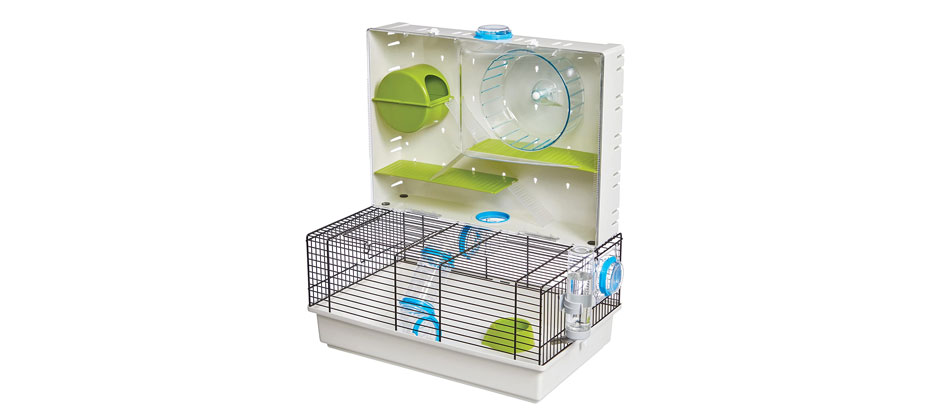
- Comes with free accessories to get you started
- It has a deep base and a door located at the top
- The upper cover is detachable
- Comes with a 1-year manufacturers warranty
For hamsters who enjoy multiple levels of living space and owners who love to watch all the fun in action, the MidWest Homes for Pets Hamster Cage is the best option out there. What’s even better is that you do not have to go out of your way to stock up this cage. It comes fully stocked with an exercise wheel, water bottle, food bowl, nesting nook as well as some interior play tubes. All your pet has to do is move in.
For further convenience, this hamster cage is fitted with a plastic base that is perfect for litter, as well as a top door and detachable cover which makes cleaning a lot easier. Even more, it offers a side port and connectors which are the right fit for standard play tubes. So, in the case that you want to connect any more fun accessories, it can happen quite easily.
- It is incredibly easy to assemble (no tools needed)
- It arrives already stocked up with accessories
- It is sturdy
- The accompanying wheel is noisy
- It easily gets messy
- The bottom tray is too shallow
6 Midwest Deluxe Critter Nation Small Animal Cage
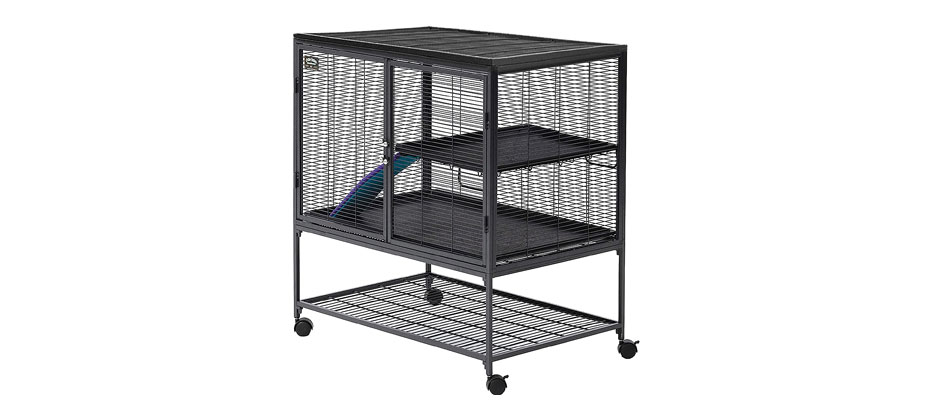
- Full-width double doors
- Locking wheel castors
- Multiple levels
- Storage shelf
- Adjustable shelving
This hamster cage requires no tools for assembly but offers plenty to pet parents and their hamsters. Firstly, the full-width double doors help to make accessing your cage incredibly easy.
In addition, customers love how quickly and efficiently they can clean their new cage without needing to take the top off the cage. As well as this, the castor wheels make moving and changing the cage even easier – with the added benefit of being lockable when required.
The multi-story hamster cage offers plenty of room for your pets, while the storage shelf beneath provides somewhere to access your supplies when you need to quickly.
One of the downsides to this option is the shallow floor trays, which can lead to a mess in the surrounding area. There have also been a few notes that the sides can be a little awkward to fit together. That said, a good hearty bang with a rubber mallet seems to do the trick here. Unfortunately, the bar spacing makes it unsuitable for smaller hamsters such as dwarf or Syrian hamsters.
- Wide doors provide easier access for handling and cleaning
- Wheels allow you to move the cage when necessary
- Lockable castors ensure the cage stays in place
- ½-inch horizontal wire spacing encourages climbing
- Shallow floor trays can lead to a mess
- Assembly can be difficult
7 Savic Hamster Heaven Metro Cage
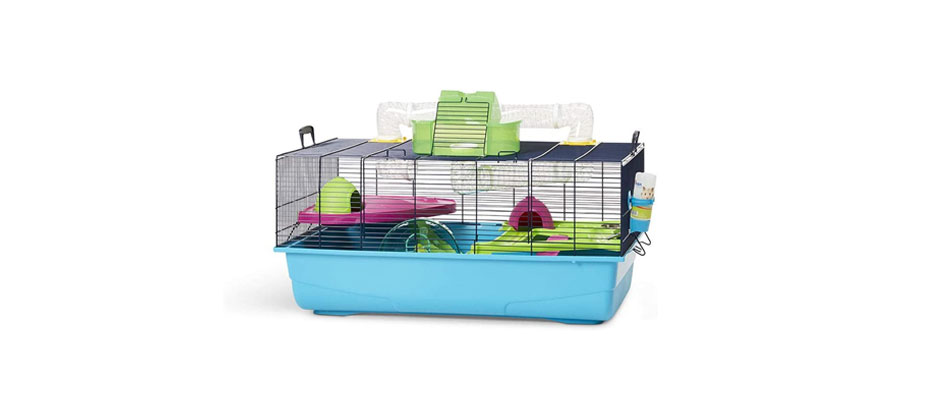
- Large base
- Carry handles
- Complete kit
- Lightweight
Easily the best choice for those who have never had a hamster before and aren’t sure what they need, this choice comes with everything – and then some. With the full range of accessories included in your purchase, you won’t be caught out without your necessities when choosing this hamster cage. These include tunnels, water bottles, exercise wheels, and more!
The cage itself is also an excellent choice for all breeds of a hamster – from dwarf to Syrian. The large base, with deep flooring, provides ample room for your pets to explore, burrow, and enjoy themselves. Meanwhile, the slim gaps between the bars help keep your hamsters exactly where you want them while providing plenty of climbing space, to boot.
- Ideal for kids, and first-time hamster owners
- Comes with the full range of accessories
- Small bar spacing is ideal for dwarf hamsters
- Large enough for Syrian hamsters
- Can be very noisy
- Assembly is a little fiddly due to additional parts
How to Choose the Best Hamster Cage
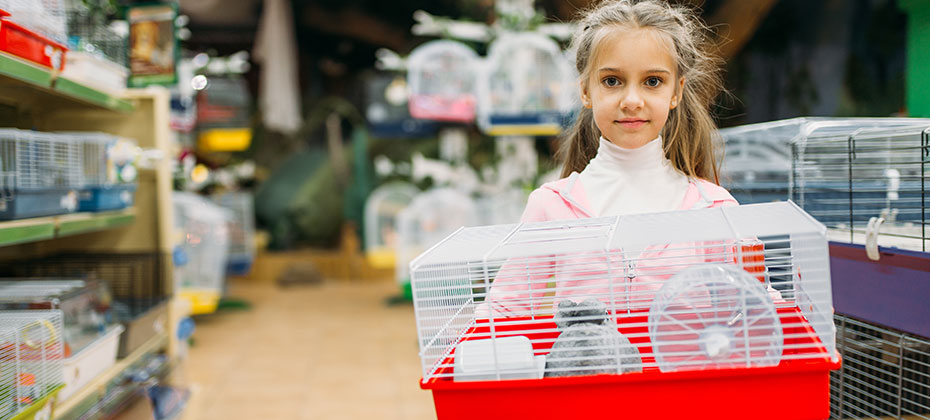
Choosing the right hamster habitat is about understanding certain requirements crucial for these critters’ well-being. Just like any creature placed in an enclosure and away from their natural habitats, hamsters placed in inappropriate houses can develop a host of health and behavioral problems that can bring a lot of headaches for the young pet owner. Here are some things to look for when buying a hamster cage.
Size matters
Have you ever tried living in a very small, cramped space where you can hardly breathe or move comfortably without bumping into anything? You know how it feels. Unfortunately, the same thing can be said of your poor hamster, especially the larger species. That’s why it is very important to look at the size of the habitat you are considering. For example, according to the National Hamster Council, if you own a Syrian hamster, each one must have no less than 150 square inches of floor space and vertical space of about 17.5 inches to move about, live in, and play in. Dwarf hamsters, on the other hand, are expected to have at least 120 square inches of floor space and a ceiling of about 7 inches from the surface of the bedding. Additionally, the Royal Society for the Prevention of Cruelty to Animals strongly recommends the observance of the minimum requirements for cage dimensions which currently stand at 30 inches by 15 inches by 15 inches. This is to help ensure that hamsters and similar pets have plenty of room to live, play, thrive, and exercise.
Wire versus plastic
Two of the most popular types of hamster cages are wire-tops and plastic tanks. Each one has its pros and cons. As a rule, wire-tops should always have a plastic bottom, as wired bottoms are considered unsafe for the small feet of these critters. Additionally, the width of the space between the wires should never be more than half a centimeter as curious hamsters can easily poke their heads through space if the gaps are any bigger. Plastic cages are preferred today primarily because they are easier to clean and provide an unobstructed view of your pets. Unfortunately, the surface walls don’t allow for climbing, so you’d have to provide additional accessories for your pets to climb on.
Living space
As we have already mentioned above, size matters. And this especially pertains to the size of the living space, including amenities for play, feeding, resting, eliminating, and even mating. The point is that the hamster habitat should provide your pets with ample space to realize their being. For instance, these pets are known for being highly active. Giving them exercise wheels, mazes, and tunnels to run through and over helps them feel more at peace with their new surroundings. That’s why their living spaces should also be considered, often in conjunction with the overall size of the cage.
Bedding depth
Hamsters are burrowing animals. They love to dig. That is why one of your major considerations is the depth of the lower tray of your prospective hamster cage. At the very minimum, you should be able to fill the bottom tray with at least 2 inches of hamster bedding. The deeper it is, the better. This is especially important if you choose a wire-top type of hamster habitat. This is because the depth or height of the bottom tray can help prevent or reduce the amount of bedding your pets might kick or push out of the habitat. Remember, there are spaces in between the wires that bedding materials can be pushed through.
Ease of cleaning
There’s one thing you have to keep in mind when choosing the right habitat for your hamsters.
It should be easy to clean.
Otherwise, your entire room will be reeking of stink from your pet’s droppings, urine, and other body fluids and excrements that may have been passed out. Understand that the more complex the cage setup is, the more challenging it is to clean. That’s why cages with complex playhouses, tunnels, exercise wheels, and other accessories can be quite a chore to clean, as you will have to remove each item to be individually cleaned. As far as cages go, wire-tops with plastic bottom trays are super easy to clean. Glass tanks or aquariums are also very easy to clean. Unfortunately, they can be very heavy.
Ventilation
All living creatures require oxygen to live. And if you’re unable to deliver as much air as your pets need, they might suffocate, too. Wire cages are superb in ventilation as the only “closed” section in the bottom tray is filled with bedding materials. If you have to choose a plastic cage, make sure that there are “windows” or panels that have wire meshes to allow for ventilation. Sadly, even with such systems, the amount of air flowing to and through the cage may not be sufficient for the optimum requirements of your pets. The same is true with glass tanks.
Safety and Security
Because they are relatively small compared to other pets, hamsters are especially vulnerable to security and safety issues. They can get their body parts stuck between wires or surreptitiously ‘unlock’ the latch to their gates or doors. These creatures have a very uncanny ability to open things as part of their instincts, searching for food. Some hamsters are also known to be tenacious chewers. Some have been observed to be particularly fond of the bars on wire cages. So, it is important to understand the unique characteristics of the hamster species you will have for a pet. If it belongs to a species that is well known for heavyweight chewing, a solid-walled habitat might be a lot better. Want a chew-proof home for your critter? A glass tank is a wise choice.
Exercise Wheels
If you have to think of one particular accessory that your hamster simply has to have, then that would be an exercise wheel. These should not have crossbars that can be quite dangerous if your pet’s feet inadvertently get caught while the wheel is spinning. Instead, experts recommend getting a wheel with a solid surface. It is also important that the wheel diameter be slightly bigger than your pet’s body length.
How Much do Hamster Cages Cost?
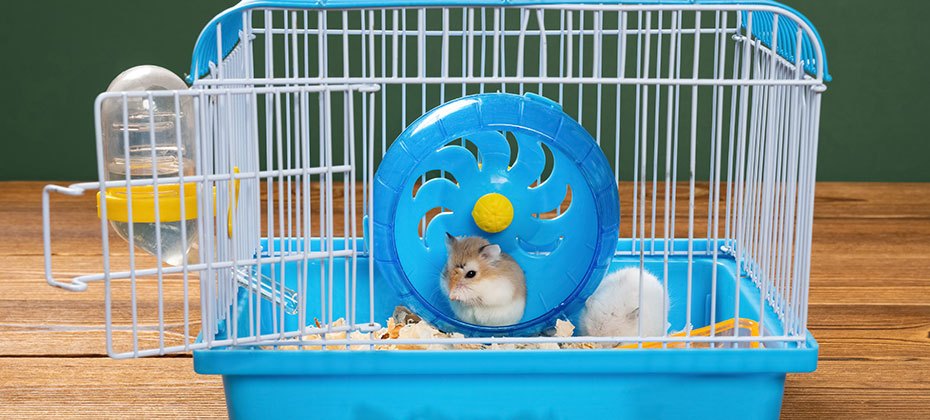
The new home of your furry pet should not cost you a fortune, although it is not uncommon to see some pet owners who treat their furry friends lavishly. A hamster habitat’s cost depends on at least five major components. Understand that each component can have a range of prices, from the cheap to the obnoxiously expensive. Consider the following to give you an idea of how much hamster cages will cost you.
- Cage – If you want a cheap hamster cage, you may want to make one yourself. Technically, you can turn any large container like a cardboard box into an elegant DIY critter tank. Using readily available materials, you won’t be spending a dime. But if you need a ready-made pen for your pet, be ready to shell out as little as $10 to as much as $100. There are also good hamster cages that can run in hundreds of dollars, often depending on the type of material used and the size of the project.
- Bedding – Beddings are important parts of your critter habitat as this is where they will be spending most of their time resting or even nesting. Basic bedding kits can set you back for as low as $2 per pack. There are also specialty beddings that cost around $10 a pack. Do understand that beddings, unlike the cage, are not permanent. So, you can easily spend around $8 to $40 per month on beddings alone, given you’re going to replace them every week.
- Dish – To feed your pets, you’ll need a durable dish or bow that they cannot chew or nibble on. Most would recommend getting a ceramic bowl as these are sturdy and durable so that critters won’t damage it. Expect to pay around $10 for a good quality ceramic bowl. But if you’re on a tight budget, you can get some cheap plastic. You should not spend more than $5 for a cheap-looking plastic bowl.
- Bottle – The last puzzle piece is your critters’ water bottle. These are preferred to water bowls as they are less messy and are a lot more hygienic for your pet. You can expect to pay around $5 for a good quality water bottle for your pet, although, as we said, you can always go for some cheap plastic bowl. Just remember that it’s messier, meaning you may have to increase the frequency of your cleanups.
- Other accessories – If you’re going to make your own hamster house, be ready to improvise on their accessories like tubes, tunnels, hideaways, and the exercise wheel. Again, you can make these from readily available and recyclable resources, and you wouldn’t spend anything except for the materials you’ll need to put these pieces together. On the other hand, if you buy fun hamster cages, the accessories are already included. If it’s a bare tank, then be prepared to spend between $5 and $20 for these accessories. Or, you can get starter kits which you can build on your own.
3 Different Types of Hamster Cages
Now that you know what you need to look for when choosing or buying the best hamster cage, it’s high time to look at the different types of hamster cages, as these will form the foundation of your journey as a hamster owner.
1. Wire-top cages
These are easily recognizable by the wire structure of the habitat combined with a plastic bottom tray. These provide exceptional ventilation, are very easy to clean, and provide easy access to your pets. Unfortunately, the bars can be chewed upon by your pet, and the spaces between bars can be excellent exit points for bedding materials pushed out by hamsters.
2. Plastic tanks
Plastic hamster cages are quite a joy to have. These often come pre-packaged with all the accessories you can imagine to start on your journey of being a hamster owner. These are fully expandable, meaning you can add other plastic hamster cage sets to make an entire ecosystem of habitats. And because you essentially have a solid wall of plastic, you can easily fill the bottom with as much bedding material as you want. Sadly, ventilation is not a great attribute of plastic tanks. The complexity of their tubes, tunnels, wheels, mini houses, and other accessories can make cleaning quite challenging. If a pet decides to hide in the middle of a long tube or tunnel, getting it out may be perplexing as forcing the animal out can hurt it or scare it. Moreover, some tenacious chewers are known to destroy exposed plastic components.
3. Aquariums or glass tanks
These can be repurposed aquariums or even especially-built glass tanks. They can be with or without lids, although if with a cover, it is usually made of a wire top extension. The beauty of the glass tank is that it secures your pets inside. The transparent nature of glass also allows for greater visibility of what your critters are doing. It’s fully chew-proof, and you can apply as deep a layer of bedding as possible. And if you happen to own a dwarf hamster, putting them in a glass tank allows for easy access. Unfortunately, this type of hamster cage is heavy.
How to Setup a Hamster Cage
Once you have chosen the right and most appropriate home for your pet hamster, it’s time to set it up before you even start putting your pet. Again, the key here is to choose the right tank or enclosure for the type of hamster that you have. If you already have the cage, here are the next steps you need to take to set up a hamster cage.
Choose a location for the hamster cage.
Hamsters need to be in a comfortable environment, preferably at room temperature. They are also particularly active at night, so putting the cage in the bedroom is not a good idea. The most suitable place for hamsters is the living room. However, you should place them where they are not exposed to loud noises as they have an acute sense of hearing.
Prepare the bedding.
Spread bedding material on the floor of the hamster cage. Make sure that it is deep enough to encourage the burrowing instincts of these furry animals. Putting bedding at least 2 inches deep should help protect your pet’s feet while allowing the smells and liquids to be absorbed more efficiently.
Add the accessories.
Once the bedding has been set, you can add extras or accessories like tunnels, play platforms, tubes, exercise wheels, food bowls or dishes, water bottles or bowls, and other stuff you might want to include. Remember not to crowd the house as your pet also needs plenty of space to roam freely.
Final Words
Hamsters make excellent beginner’s pets, especially kids. But, like all pets, they also deserve the right house to thrive and fulfill their being. Knowing what you need to look for when choosing the right hamster cage is crucial to caring for them correctly. With these seven best hamster cages we’ve prepared for you, we’re confident you’re on the right track toward becoming a great hamster owner.
Sources:
- Laurie Hess, DVM, Housing Rodents, VCA Hospitals
- Is a hamster the right pet for you?, The Humane Society
Best Hamster Cages FAQs:
Turning a cage into a home fit for your furry little friend is not a difficult feat. To make this happen, they will need bedding, such as wood shavings, to be placed at the bottom of the cage so they can burrow and hide as they please. They will also require a water bottle or dish, a food dish, and a sleeping area. Of course, this would all be quite dull without the presence of some toys such as exercise wheels, tunnels, stairs, and ramps.
Wire cages have pros and cons; when compared to tanks, they are not as safe and secure. Not only can pet’s gnaw their way out, but kids can also get their fingers stuck between the bars. Nevertheless, they provide a nice and airy environment for pets to thrive in and are also better for attaching accessories and habitats.
Regarding Syrians, it is best to opt for a wire cage. Syrians require a lot of air to thrive, and thanks to their tiny lungs, the expanse of a wire cage is the best option. Another feature to look out for is the flooring of the cage; it is best to opt for a wire cage with a plastic floor to guard against their feet getting caught in the gaps.
If the aim is to give your pet hamster a comfortable and sound sleep at night, covering your hamster cage is not necessary at all. Hamsters are nocturnal beings, and darkness encourages them to stay awake.

